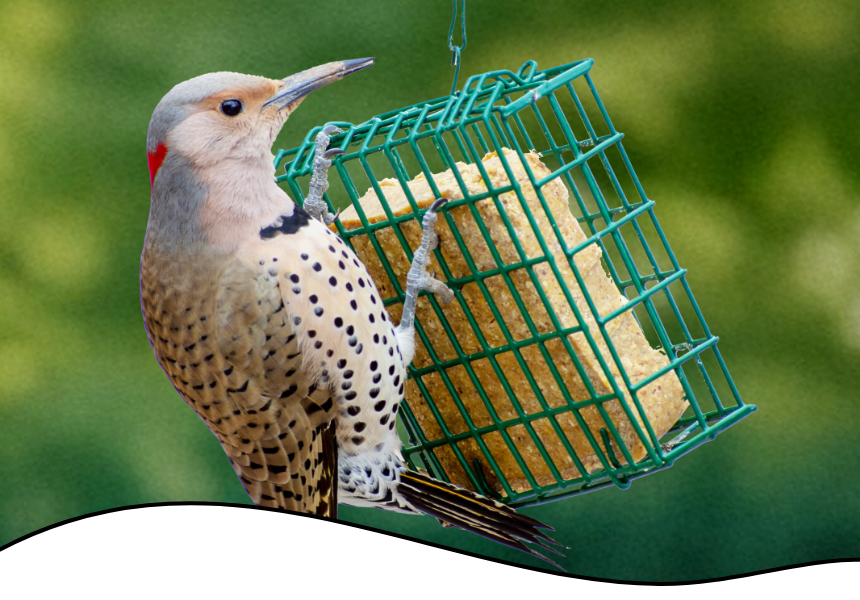WILD BIRD SUETS: A GUIDE TO GETTING STARTED
New to the world of wild bird feeding? You aren’t alone. Millions of people annually feed birds across the United States, and they all started somewhere. As a leader in wild bird suet, C&S Products is here to help your new hobby take flight. Below is our complete beginner’s guide to wild bird suet.
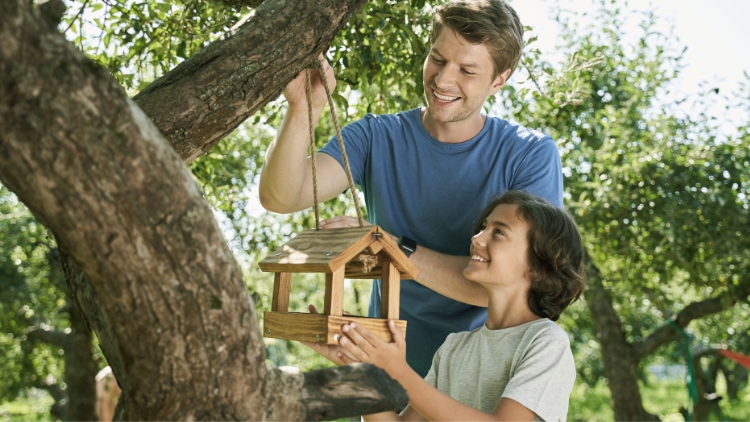
WHY FEED WILD BIRDS?
There’s a reason millions of people each year actively attract and feed wild birds. In fact, there are several benefits to feeding and hosting wild birds in your yard.
Reason #1: Wild Birds Are Beneficial for Yards
First off, wild birds are extremely beneficial to a yard and those who enjoy being outdoors. They eat large quantities of insects and are one of the best natural means of pest control year-round.
Reason #2: Wild Birds Bring Beauty
Wild birds come in a variety of vibrant colors, and their unique songs bring richness and liveliness to any yard. Plus, feeding and caring for wild birds can help children gain an early understanding and appreciation for nature by watching them flock to their feeders.
Reason #3: Wild Birds Bring Good Vibes
Last but certainly not least, feeding wild birds makes us feel good. This is more than a hobby. It’s an opportunity to immerse yourself into nature’s beauty. The joy that emerges when these winged visitors arrive can’t be matched. And that feeling is especially rewarding in colder climates, where easy meals at backyard feeders can deliver the essential nutrients and energy needed when food can be harder to come by.
Ultimately, wild bird feeding is a tremendous way to help assist bird conservation efforts.
HOW TO IDENTIFY WILD BIRDS
Suet feeders can attract a wide variety of wild birds to your yard, most notably woodpeckers, wrens, chickadees, nuthatches, thrashers, titmice, bluebirds, thrushes, grosbeaks, catbirds, cardinals, mockingbirds, and jays.
The question is, how do you identify these flying visitors? Here are four keys to use as a guide:
- Size & Shape
- Color Pattern
- Behavior
- Habitat
WHAT IS SUET?
Suet is a high-energy, nutritious food source for birds, typically made from rendered animal fat. Suet is particularly important in the winter, as it helps birds maintain their energy levels during colder months. Suet feeding isn’t restricted to only the winter months, as it has become a year-round activity and supplements a regular seed feeding program.
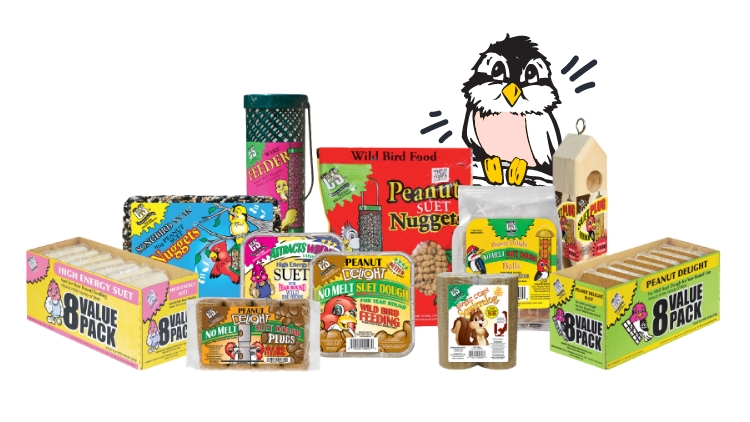
WHAT’S THE DIFFERENCE BETWEEN SUET AND BIRDSEED?
Suet offers easily digestible fat and calories to provide quick energy to wild birds, making it a more ideal option for fall and winter feeding when birds need more calories to maintain body heat. Suet also provides quick energy bursts for migrating birds, so you can help them along their challenging journeys.
There are plenty of benefits to using suet over birdseed for hobbyists. It’s less likely to spill when tipped or knocked over, which means less waste and less mess. Plus, suet won’t turn into weeds in your lawn or garden.
HOW TO CHOOSE FROM SUET TYPES
Here’s a complete guide on how to choose the right suet types, ingredients, and seasonal options to bring a variety of birds to your feeders.
Types of Bird Suet
Choosing the right form of suet is key to attracting specific types of birds. Here are the most popular options:
- Suet Cakes and Balls: The most common suet form, seed cakes, and fat balls are versatile and easy to use in a variety of feeders. Suet cakes are ideal for general backyard bird feeders, while balls work well in specialty feeders that attract woodpeckers, nuthatches, and more.
- Suet Plugs and Nuggets: Designed for feeders with smaller, vertical holders, suet plugs and nuggets attract species like woodpeckers and smaller songbirds. Plugs can be placed in natural settings, like tree trunks, to mimic the birds’ natural feeding behaviors.
Suet Ingredients to Attract Different Types of Birds
Not all suet is created equal. Ingredients vary to attract different bird species, making it easy to choose the right suet to encourage a variety of visitors.
- Fruit-Based Suet: Birds like robins, bluebirds, and orioles are drawn to suet made with berries and other fruits. Fruit-based suet is a great choice if you want to attract these colorful species to your yard.
- Nut and Seed Suet: For woodpeckers, chickadees, and jays, nut- and seed-rich suet provides the protein and fats they need. This type is perfect for adding diversity to your birdwatching experience.
Seasonal Suet Selection for Your Backyard Birds
Choosing the right suet for each season can help birds thrive year-round.
- Spring and Summer: In warmer months, go for no-melt or hot-weather suet varieties, which resist spoilage in the heat. Fruit-based suet is also ideal for summer, adding hydration to birds’ diets.
- Fall and Winter: As temperatures drop, high-fat suet with extra nuts and seeds is essential to help birds maintain their energy levels. High-energy suet cakes or balls are excellent options for colder weather, and you may attract migratory birds during these seasons.
Storage Tips for Suets
Proper suet storage helps maintain freshness and quality, ensuring birds get the best food possible.
- General Storage: Keep suet in a cool, dry place to prolong freshness. For longer storage, refrigerate or freeze suet packages to prevent spoilage, particularly during warm weather.
- Winter Storage: In winter, store suet indoors to avoid freezing or hardening, which makes it harder for birds to eat. Keeping suet in moderate temperatures will ensure it’s fresh and easy to access.
Why Homemade Suet Isn't Ideal
While using a suet recipe may seem simple, here's why it's best to trust professional products to ensure bird safety and satisfaction.
- Ingredient Safety: Homemade suet can pose risks if incorrect fats or household ingredients are used, as some may be harmful to birds.
- Proper Preservation: Professional suet, like those from C&S Products, is specially formulated and preserved to prevent spoilage. DIY suet may not hold up in extreme temperatures, risking contamination.
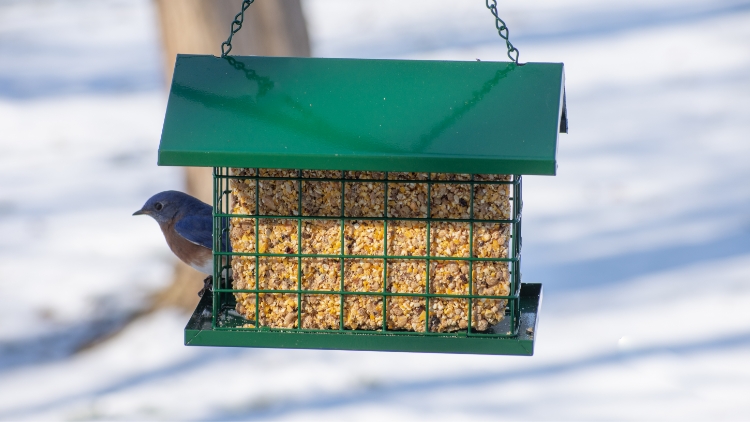
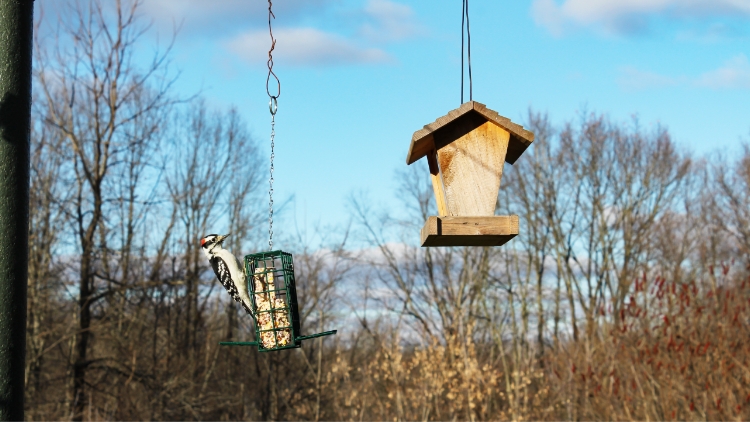
DIFFERENT TYPES OF SUET FEEDERS
There are several different types of bird feeders that work in attracting wild birds to a yard. The basic types of bird feeders that attract wild birds are:
- Hanging feeders and baskets: Usually made with a sturdy metal cage or frame to secure the suet, these feeders can hang from tree branches, poles, or hooks in your yard. Types include: suet block feeders, upside down suet feeders, basket cage and holders
- Hopper feeders: Usually constructed of wood, these feeders have an attractive, rustic look. Larger models hold larger quantities and allow several birds to perch at once.
- Tube feeders: Available in plastic and/or metal-reinforced models. Tube feeders are one of the most popular styles of feeder available because they are easy-to-fill, hang, and hold a lot of seed.
Choosing a Feeder
The first step in choosing the right feeder is to choose one that’s quality-made, as it’s more likely to last over the long haul. Here are some other tips for choosing the right suet feeder:
- It should be easy to take apart and clean.
- Clear parts should be plastic and not glass (preferably Lexan brand plastic, which is unbreakable, shatterproof, and cannot be chewed by squirrels and other predators).
- A feeder should protect the seed from rain and snow. It’s also wise to choose a feeder with small holes on the bottom or sides to ensure proper drainage.
- A feeder should have metal perches and reinforced openings (if a tube feeder), so squirrels cannot chew them.
Cleaning and Maintaining Your Suet Feeder
Feeders should be cleaned regularly by thoroughly scrubbing with hot water and detergent. Always dispose of any old or moldy food at all of your feeders, including ground feeders, to avoid any possible harm to the birds. The cleaner your feeders are, the more likely you’ll get repeat visitors.
HOW TO ATTRACT WILD BIRDS TO YOUR SUET FEEDER
Here’s what anyone getting into wild bird feeding should consider when it comes to attracting wild birds to your feeders.
- Location: A feeder should manipulate birds so they can be properly viewed. The type of feeder you choose will determine where it can be placed. However, some birds may never come to a feeder if they are positioned too close to the house or lack proper cover from other predators.
- Feeder height: An ideal setup for attracting a wide variety of wild birds to a yard would include:
- Some ground feeding
- A platform feeder on a post about 5 feet off the ground
- Several hopper, tube or Nugget feeders suspended by wires anywhere from 5-to-8 feet high
- A thistle feeder, a window feeder and a suet feeder mounted on tree trunks at various heights
- Variety of feeder placement: If there is space, consider having 2 or 3 different bird feeding areas or stations, each about 50 feet apart. Placing multiple feeders in and around different vegetation and at different heights, the more likely you’ll attract wider varieties. Pro tip – in winter, birds will flock to the most sheltered locations to stay out of the wind.
Tips for Protecting Your Feeders
Feeding stations are not just attractive to birds, but nuisance birds (like Starlings), squirrels, and cats. Nuisance birds primarily prefer ground feeding, so you may prefer to select a site well away from the house and feeders to scatter seed to draw nuisance birds away from bird feeders.
Squirrels can cause a ruckus for wild birds and their enthusiasts. Suet feeding is a free meal for them too, after all. While it might be impossible to rid your yard of squirrels, there are some ways to keep them out of your feeders.
The key is to divert the attention of squirrels away from bird feeders. Squirrel feeders are often designed to have a table and chair with a nail coming from the top of the table. A squirrel will sit down and enjoy their feast just as the feeder suggests. The nail can easily accommodate a C&S Squirrelog (the favorite food of squirrels) or an ear of corn. C&S Squirrelogs are produced with compressed Sweet Corn and offer more food and entertainment value for the dollar. One Squirrelog equals 20+ ears of corn. For more entertainment use our Squirrelog Hanger that creates a moveable unstable feeder that the squirrels will go into contortions to eat from.
C&S also offers a variety of squirrel feeding products, such as our WILDLIFE “BIG BLOCK” SNAK and SQUIRREL SNAK items. These products are made to withstand even the most voracious squirrels as well as provide a steady diet of sweet corn–a squirrel’s favorite.
But in some cases, feeding squirrels is not enough to keep them away from bird feeders. When this is the case, it’s recommended that baffling devices be used whenever and wherever there is squirrel activity. To baffle squirrels and keep them from a feeder, take the following steps:
- Hang the feeder at least 8 feet away from the nearest access, such as a tree trunk or limb, and 5 to 6 feet off the ground.
- Use Squirrel Baffles—umbrella-shaped physical barriers that squirrels are unable to crawl over on any wire that leads to the feeder. Another tip—lubricate the baffles (Vaseline or WD-40, for example) so that the squirrel simply slides off rapidly.
- On a pole-mounted feeder, place baffles at least 4 feet up on the pole below the feeder. Remember to keep the feeder far enough away from trees or anything that the squirrel could use to jump from so they cannot jump to it.
- Place your Squirrelog or Snak Cake squirrel feeders away from your wild bird feeders.
GARDENING FOR BIRDS
The most important concept to understand in attracting wild birds is variety. Birds live in different habitats and the greater the variety of habitats that are created – the more birds and species that will be attracted. The key to creating different habitats is offering food and nest sites at all levels. This can be accomplished by keeping gardening for wild birds in mind.
There are basically four levels of habitats that may be created and maintained in a yard:
- GRASS LEVEL. Anywhere from 2 inches to 1 foot high (this would represent just a portion of your yard, not the whole yard).
- SHRUB LEVEL. 2 to 5 feet high. The best bird plantings at this level would include Honeysuckle (shrubs, not vines), Junipers (that grow from 2 to 5 feet tall), and Barberry.
- SMALL TREE LEVEL. 5 to 15 feet high. The best bird plantings at this level are Crab Apple (get trees that have abundant, small apples), Juniper (get species that grow from 10 to 20 feet tall), and Hawthorn.
- TALL TREE LEVEL. 15 to 40 feet high. Try to offer a variety of foliage and foods at this level. The best bird plantings at this level are Pines, Spruce, and Hemlock (for cones and cover); Maple, Ash, Elm and Birch (for seeds); Cherry, Mulberry, and Mountain Ash (for berries); and Oak (for nuts).

There are many easy and inexpensive ways to create a variety of habitats:
- Create one or more loose piles of brush with limbs, branches, and old Christmas Trees.
- Let a part of the lawn grow tall and don’t mow it. The minimum area would be 10 feet by 10 feet.
- If there is part of the yard that is overgrown with weeds and shrubs - leave it alone.
- Leave dead trees standing and dead limbs on trees, if they are not a hazard or eyesore.
- If surrounded by trees, cut down a few to make a little clearing. On the other hand, if surrounded by clearing, plant a few shrubs and trees.
It's also important to consider nesting sites where birds can raise their young. Nesting boxes or birdhouses can be placed anywhere from 3-to-10 feet high on a tree or post (basically anywhere that is not disturbed by human activity). For best results, put up a birdhouse in the fall or winter so the birds have a chance to get used to it.
FAQS ABOUT WILD BIRD SUETS
- How often should I clean my suet feeder? Suet feeders should be cleaned at least every other week.
- How can I keep squirrels from eating the suet? C&S has developed Squirrelog products and feeders that help divert squirrels away from wild bird suet feeders.
- What birds are attracted to suet? Birds like robins, bluebirds and orioles are drawn to suet made with fruit, while woodpeckers chickadees and jays seek out nut and seed-rich suet.
- Can I make my own suet? We advise using professional suet products to ensure ingredient safety and proper preservation.


